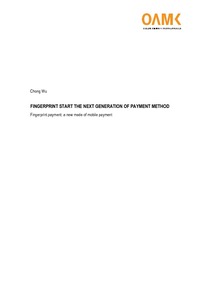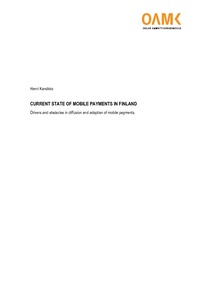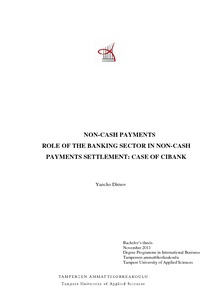The Usage of Physical Cash and its Implication on Small Restaurant Businesses in Helsinki
Sneih, Janan (2025)
Sneih, Janan
2025
All rights reserved. This publication is copyrighted. You may download, display and print it for Your own personal use. Commercial use is prohibited.
Julkaisun pysyvä osoite on
https://urn.fi/URN:NBN:fi:amk-2025053118806
https://urn.fi/URN:NBN:fi:amk-2025053118806
Tiivistelmä
This thesis explores how small restaurant businesses in Helsinki are responding to the shift toward a cashless society. Recent trends in Finland indicate a clear decline in the use of cash, although physical currency remains in use among certain groups, such as older adults and international tourists. As digital payment methods continue to grow in popularity—accelerated by technological development and the COVID-19 pandemic—understanding the impact on small businesses has become increasingly relevant.
The aim of this research is to investigate how a cashless future may influence small restaurant operations, based on the perspectives of business owners. Specifically, it explores the benefits and challenges of using cash, the operational and customer-related reasons for its continued use, and the potential risks businesses may face if physical cash were no longer accepted. These research objectives are examined through the lens of the Technology–Organisation–Environment (TOE) framework.
The research applies a qualitative approach and is based on semi-structured interviews with five small restaurant owners in Helsinki, conducted between June and November 2024. Thematic analysis was used to identify recurring patterns and context-specific insights related to payment practices.
The findings show that while digital payments are generally preferred for their speed, hygiene, and convenience, cash continues to serve important roles—particularly for tourists, older customers, and as a backup during technical issues. Owners also raised concerns about the costs of digital systems, security risks with physical cash, and the need to make decisions based on limited resources.
This study contributes to a limited body of research on digital payment adoption in small hospitality businesses. It offers practical insights for policymakers, service providers, and business owners by highlighting the importance of flexibility, inclusiveness, and operational resilience in the face of ongoing digital transformation. Further research could include customer perspectives or comparisons across other cities or sectors.
The aim of this research is to investigate how a cashless future may influence small restaurant operations, based on the perspectives of business owners. Specifically, it explores the benefits and challenges of using cash, the operational and customer-related reasons for its continued use, and the potential risks businesses may face if physical cash were no longer accepted. These research objectives are examined through the lens of the Technology–Organisation–Environment (TOE) framework.
The research applies a qualitative approach and is based on semi-structured interviews with five small restaurant owners in Helsinki, conducted between June and November 2024. Thematic analysis was used to identify recurring patterns and context-specific insights related to payment practices.
The findings show that while digital payments are generally preferred for their speed, hygiene, and convenience, cash continues to serve important roles—particularly for tourists, older customers, and as a backup during technical issues. Owners also raised concerns about the costs of digital systems, security risks with physical cash, and the need to make decisions based on limited resources.
This study contributes to a limited body of research on digital payment adoption in small hospitality businesses. It offers practical insights for policymakers, service providers, and business owners by highlighting the importance of flexibility, inclusiveness, and operational resilience in the face of ongoing digital transformation. Further research could include customer perspectives or comparisons across other cities or sectors.
Kokoelmat
Samankaltainen aineisto
Näytetään aineisto, joilla on samankaltaisia nimekkeitä, tekijöitä tai asiasanoja.
-
Fingerprint start the next generation of payment method : Fingerprint payment: a new mode of mobile payment
Wu, Chong (Oulun ammattikorkeakoulu, 2016)In the generation of mobile internet, fingerprint payment is one of the most popular topics at the moment. China has a big market and many users are using the mobile payment methods. There are a large number of mobile ... -
CURRENT STATE OF MOBILE PAYMENTS IN FINLAND : Drivers and obstacles in diffusion and adoption of mobile payments
Karsikko, Henri (Oulun ammattikorkeakoulu, 2015)The topic of this thesis originated from the working life, in spite of the fact that the topic was not commissioned by any company. The importance of digital services and the transition from computers to mobile devices ... -
Non-cash payments : Role of the banking sector in non-cash payments settlement: Case of CIBANK
Dimov, Yancho (Tampereen ammattikorkeakoulu, 2011)The purpose of this paper was to reveal the nature, role, place and importance of non-cash payments in the worldwide economic life with an emphasis on the Bulgarian reality. It clarifies the causes and consequences of the ...



